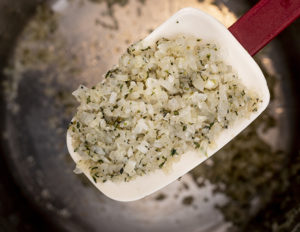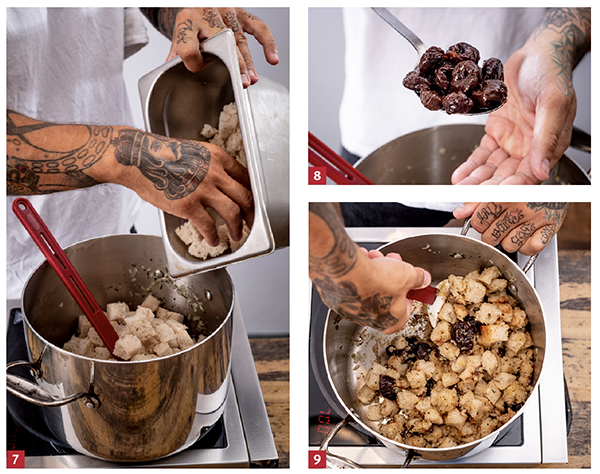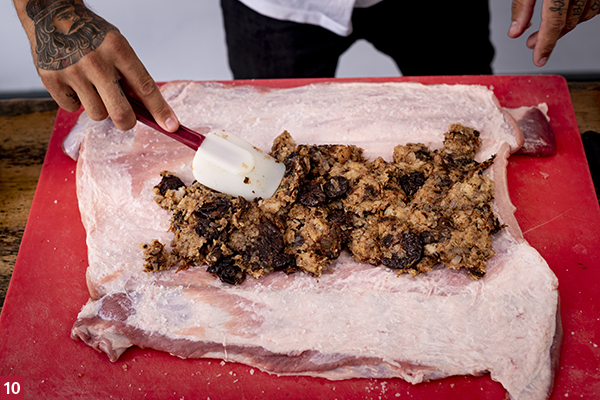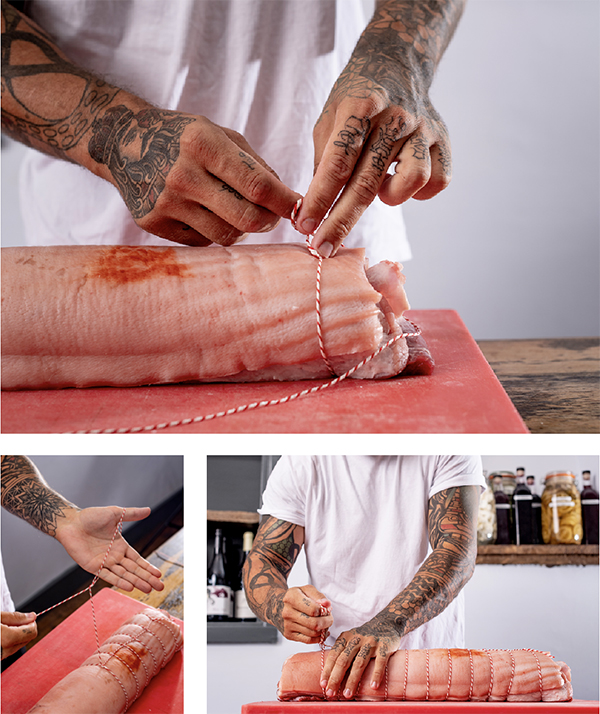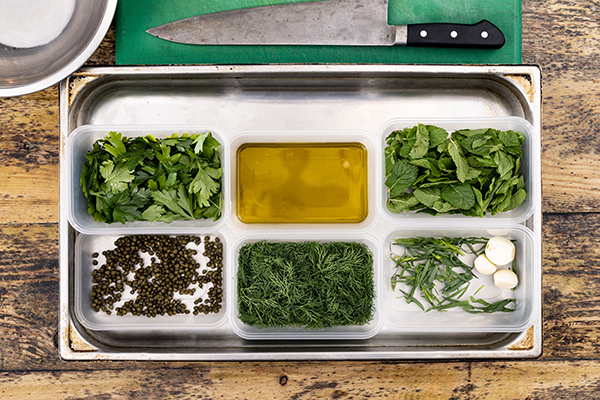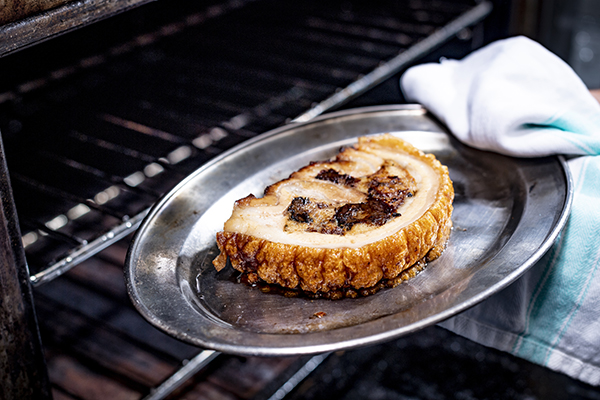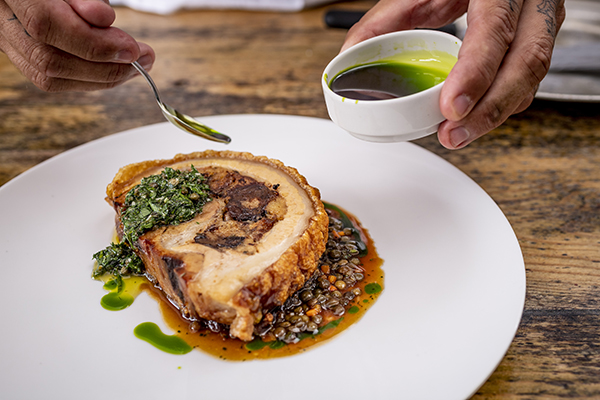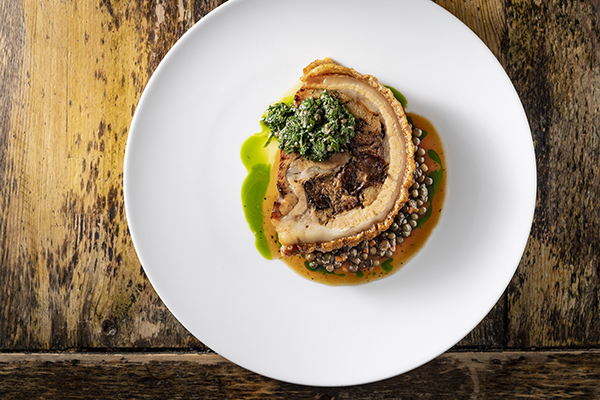On a roll: Gary Usher's masterclass for a roast stuffed pork belly
Chef-proprietor Gary Usher takes a break from his burgeoning restaurant empire to prepare a comfort food classic, roast stuffed pork belly. Michael Raffael reports
Roast pork belly surfaced as a restaurant dish at the height of the modern British cookery movement, with its success owing more than a nod to Fergus Henderson's Nose to Tail Eating and slow food, rare-breed meat and gastropubs all playing their part.
Costing
Roast stuffed pork belly is a popular dish on the Sunday lunch menu (two courses for £20; three courses for £24) at both Hispi and Sticky Walnut. Rare-breed pork belly cost about £7.50 a kilo and a 4kg piece yields 12 portions, with 1kg of prune stuffing adding a further £3. The trimmings tag on an extra £1.50 per portion.
Planning
â¢Â The prunes can be prepared up to two weeks in advance, but for a minimum of 48 hours
⢠Use old bread to make the stuffing
⢠Bone, stuff and tie the joint
⢠Flash-roast and then slow-roast the pork for eight hours.
⢠Chill, portion and reheat to order.
Preparing the pork belly
This is actually a kind of porchetta joint minus the loin cut from directly below the eye muscle. You will need a 4kg pork belly joint, rind on, unscored, bone in (ribs from the best end attached). Approximate size is 40cm x 25cm (a little smaller than the standard chopping board). Choose breeds of pig such as Middle White, Saddleback or Gloucester Old Spot, which have shorter loins and deep flanks.
Lay the joint skin-side down (1). Bone out the ribs and remove the flap of skirt (2), reserving for terrines (3). On the flesh and fat surface, cut down through the middle of the belly along its length with the knife point, following the muscles, scoring the meat deeply to around 2cm above the rind (4). Slide the knife under the meat and open a flap on one side. Repeat with the second flap, so the jointâs surface is large enough to encase the stuffing (5).
Sprinkle the surface liberally with Maldon sea salt and leave for a few minutes before adding the stuffing.
Prune and cognac stuffing
Usher uses focaccia or old sourdough made with a light rye flour, but the recipe will also work with good quality baguette. The weight will vary according to the type of bread chosen. At Hispi one stale loaf, crusts removed and cubed, weighs a little less than a kilo.
60ml olive oil
175g onion, finely diced
1tbs rosemary, chopped
1tbs thyme
2 crushed garlic cloves
900g approximate sourdough bread, cubed
Salt
250g prunes in cognac plus a little of their macerating liquid and/or cognac (see below)
Heat the oil in a pan and sweat the onions until translucent. Add the herbs and garlic and continue cooking over a low flame until they are fragrant. Combine with the bread and season lightly, bearing in mind that the pork has already been salted (7).
Stir in the prunes and liquid (8) and work into a compact mass. Add an extra splash of water if the bread is on the dry side (9).
Lay the stuffing on the joint (10) and fold the edges towards the centre (11). Then, roll the whole joint so the loin is uppermost (12). Tie the joint at 3cm intervals, roughly the thickness of a portion (see below on tying a butcherâs knot).
Preheat the oven to 250°C. Brush the rind with a little neutral oil and put it on a roasting tray. Bake until the rind turns to crackling and is crisp, for about 20 minutes.
Open the oven door, turn down the temperature to 86°C and then slow roast the pork for eight hours. Cool ahead of service. For each portion carve a slice weighing approximately 300g off the main joint and reheat to order.
The butcherâs knot
This is the ideal way to tie joints of meat:
1 Drape the string loosely around the palm to form a loop with the string-end beneath it.
2 Pass the end of the string over the loop. Use it to make a separate small U-shaped loop over the hanging length of string.
3 Pass the string end under the hanging length of string and back up through the small U-shaped loop. Tighten the hitch.
4 Ease the large loop around the joint of meat, slip it into place and pull it tight. This forms a hitch with a double slipknot.
5 To secure the knot, pass the string end over and under the main length of string, close to the knot youâve just made. Pull the end through this new loop and pull it tight.
When fastening a joint with several ties, repeat steps 1-4. (YouTube has several videos demonstrating this.)
Prunes in cognac
Poach 1kg of stoned prunes in a litre of Earl Grey tea (three tea bags) until they start to plump. Cool and add 100ml cognac. Refrigerate for 48 hours minimum before using, but the longer the better. Add a little extra cognac before use.
Green sauce
Chop quite coarsely, but with a very sharp knife: 40g dill, 25g mint, 8g tarragon, 75g flat leaf parsley, three crushed garlic cloves and 100g Lilliput capers. Combine with 400ml olive oil and 40g Chardonnay vinegar and add sea salt to taste. Use the sauce on the same day it is prepared.
Roast pork belly, prune and cognac stuffing, lentils and green sauce
Serves 1
1 x 300g slice stuffed pork belly
150g cooked Puy lentils (see note)
25g green sauce
Preheat the oven to 220°. Reheat the pork till the crackling is very crisp, about 15 minutes.
Serve the pork on a bed of lentils with a spoonful of the green sauce on top (14).
Note: At Hispi the lentils are cooked plainly and then bound with a heavily reduced red wine and brown chicken stock jus.
Gary Usher

As a PS he points out that the misplaced apostrophe was down to his dyslexia. But this is a war he appears to be winning, thanks to his savvy use of social media. Unconventional, self-deprecating and fluent, he talks about himself in media soundbites, for instance: âThe restaurants arenât managed by me at allâ; âI donât know what my role is. Iâm a reactive personâ; âI turned down Great British Menu three years in a rowâ; âThe less I cook, the more I get asked to cookâ; âIâm a creative restaurateur, not a creative chef.â
His success, he confesses, owes little to business nous. Instead, he knows what tastes good and what his public likes to eat. This experience comes from a solid apprenticeship: Chapter One, Chez Bruce, Angela Hartnett and, yes, Jamie Oliver.
When he opened his second and third bistros, Burnt Truffle and Hispi, he would oversee menu planning: âI was still writing dishes for some of them or Iâd give them the base idea and theyâd come up with something. If a chef wanted to put a new dish on, heâd text me, Iâd drive over to the restaurant, check it out and it would go on the menu.â
That changed after he promoted Richard Sharples from Hispi head chef to the groupâs executive chef a year ago. âRich does the tasting and signs it off, which is much better because my repertoire of dishes is small. Heâs not involved with all the dishes.â
As part of his crowdfunding campaigns to raise capital for new bistros, he will go to the homes of those pledging £2,000 or more and prepare them a dinner with wine. He has also cooked for the cameras (âI told the cameraman I was shaking while I was platingâ) on a Channel 4 documentary about his latest venture, Pinion, which opened in Prescot, Merseyside, last month.
Shooting the documentary has taken four to five days a week for the past four months, but that hasnât stopped Usher looking for new sites: âIâm working out whatâs next for us all the time. I want to be as busy as possible and I hope that Iâm not spreading myself too thin; that Iâm doing things that will make the business stronger, not weaker.
âWe havenât had any failures yet, but that doesnât mean we wonât. Iâm not a businessman; Iâm a cook, and the rate at which we are opening restaurants is not advisable. Anyone with a business background would say ânoâ.â
Exclusive: Gary Usher on his most ambitious Kickstarter yet >>
Top 100: Gary Usher, Elite Bistros of the World >>




